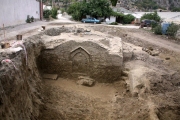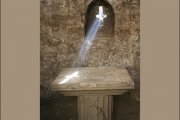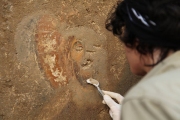|
Viewings: 8883
In the fourth century Bishop Nikolai turned the city to the World on the Mediterranean coast in the capital of the Christian world. Later this figure was canonized, and it turned into our Nicholas and Santa Claus, but the World was waiting for the less fortunate fate. About 800 years, this place served as a center of attraction for pilgrims, and then it disappeared under the sediment local river Miros thickness of 5.5 metres. Preserved only in the Church. Nicholas, part of the Roman amphitheatre and tombs carved into the rocky hills. But now the World is returned. In 2009, archaeologists have found the location of a city with GPR in keeping with modern Demre in the Turkish province of Antalya. The ensuing two-year excavations have revealed a beautiful little chapel of the XIII century in an amazing state of preservation. On one wall of a building carved window in the shape of a cross, through which the sunlight, taking the appropriate form, fell right at the altar. Has surprised experts and unusual for these places colourful mural. The integrity of the structure shows that under the ground archaeologists can wait for new Pompeii. The world arose at least in the IV century BC and was one of the most powerful cities of Lycia, with a unique culture, the roots of which go back to the bronze age. Then it was captured by the Persians, was allinternal Greeks and eventually seized by the Romans. Relics Of St. Nikolai kept, as it was considered, built in the fifth century and rebuilt many times since then the Church has attracted pilgrims around the Mediterranean. Souvenirs shops for Orthodox are in the vicinity of the ancient Worlds to this day. But the city, of course, was interested not only by believers. In the VII and IX centuries attacked by several Arabs, in the XI - finally captured by the Seljuk Turks. It is believed that the relics were stolen by some merchant, allegedly acting on behalf of the Pope, and transported to the city of Bari in southern Italy. To XIII century World is almost empty. And yet someone was built there a small chapel. Building material were stones from other buildings and tombs. Only several decades later torrential rains led to the fact that within a few years the World was covered with a thick layer of dirt. If it happened gradually, the upper part of the chapel would suffer stronger bottom, but archaeologists have found that almost all of the building (except the tip of the dome) remained at approximately the same condition. Engin Akyurek from Istanbul University (Turkey) and his colleagues unearthed artifacts beginning of the fourteenth century, when control over Anatolia received the Turks, who founded later the Ottoman Empire. After that, judging by the ceramic fragments, the first settlements in the vicinity of the Worlds began to appear only in the XVIII century. The possibility of finding new Pompei really care professionals, because the process of transformation of the ancient cities in the Byzantine studied not very good, especially in the era of the mid-seventh until the beginning of XIV century. The situation is complicated by the fact that every major settlement had its own history. Food for thought has already been submitted, and the first dish was a fresco of the excavated chapel height of two meters. It Deesis - canonical storyline Eastern Christian iconography. As a rule, in such cases, Christ Pantocrator (the Almighty) is depicted on the throne with the book in hands accompanied Mary and John the Baptist, whose hands raised in prayer. The difference frescoes from the Canon is that John and Mary hold scrolls with the Greek text. "Behold the lamb of God Who takes away the sin of the world", - this quotation from the gospel of John (1:29) researchers have read on a scroll of John the Baptist. Mary shows a fragment of a prayer to our lady, in which she, on behalf of humanity intercedes before Jesus asking to forgive our sins. A similar version of the Canon met in Egypt and Cyprus, but Turkey never before. Excavations are continuing. Special attention now get a Roman amphitheatre, restored in the second century, after a powerful earthquake srovnavaci land most of Lycia, and Andriake port Worlds, located in 5 km to the South. In this place, which for many centuries was one of the most important ports in the Mediterranean, St. Paul got on a ship that went to Antioch (now Antakya). There has already been found, workshops for manufacturing Royal purple and blue dyes from mureks (kind of snails)and synagogue V century - the first evidence of Judaism in the Christian Lycia. A significant part of the Worlds lies under the buildings of modern Demre, so archaeologists in trouble. They buy property in order to prevent illegal excavations, although, judging by the scarcity of finds, looters will be disappointed: the last inhabitants of the Worlds, fleeing from the flood, taking the time to gather as it should. Prepared according to the New York Times.  Com-Eva: 0 Com-Eva: 0
You are reading news В Турции, возможно, обнаружены новые Помпеи
if You liked the article В Турции, возможно, обнаружены новые Помпеи,
prokomentiruet her.
|
The world of the unknown - Onua.org
Onua.org - this site created to familiarize the user with the world of the unknown, news of technology, space discoveries and mysteries of the Earth UFO, Video , Photo, the Witnesses, the mysteries of history and ancient civilizations.
Menu
- Anomalies
- Hypothesis
- The Mysteries Of History
- Unknown
- News
- Opening
- Top secret
- Prophets
- Ancient civilizations
- Egypt
- Rome
- Greece
- Anunaki
- Nazca
- Maya
- Cosmos
- Technology
- Flora and Fauna
- Atlantis
- Bermuda triangle
- Aliens and UFOs
- Cloning
- Loch Ness
- Mysticism and Magic
- Time machine
- Parallel world
- The Tunguska meteorite
- Third Reich
- Teleportation
- Snow man
- 2012
- Nibiru
- Solar system
- The sun
- Earth
- Mars
- The rest of the planet
- Photo
- Video
- A little about everything
- Украинские аномалии
- 2013-2014 YEAR
- Questions and answers
- 100 great
Interesting
Recent VIDEOS
News calendar
Join
Popular Onua.org
Photo

The biggest fish in the world - not blue whale as one might think, because the whale belongs to a ma

Before it was invented fridge, its functions were performed in the ice, which was considered a preci
Предлагаем восстановить, заказать, купить диплом Вуза в любом городе России. Только настоящий бланк ГОЗНАК с гарантией.















